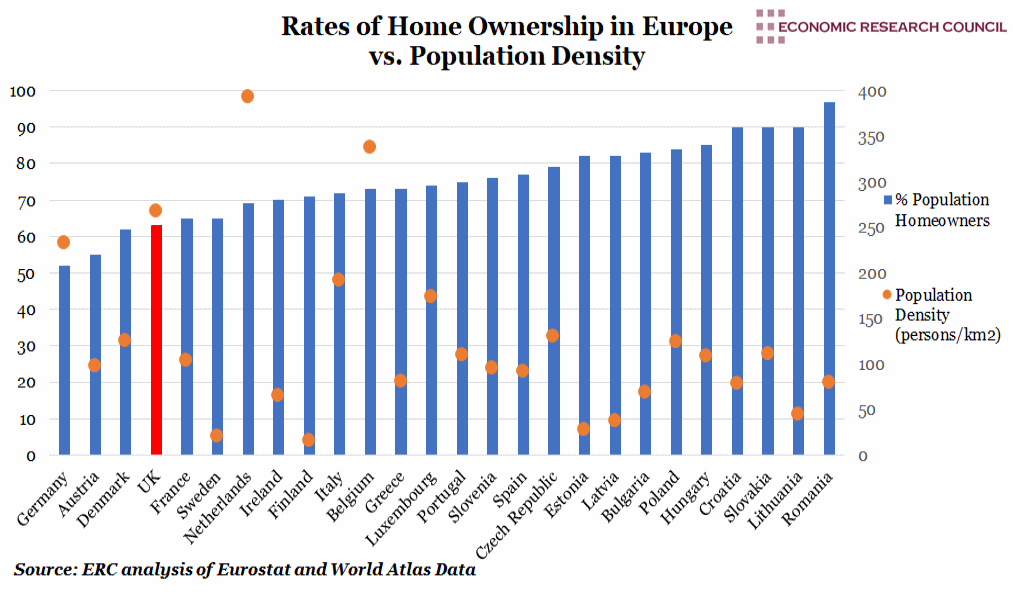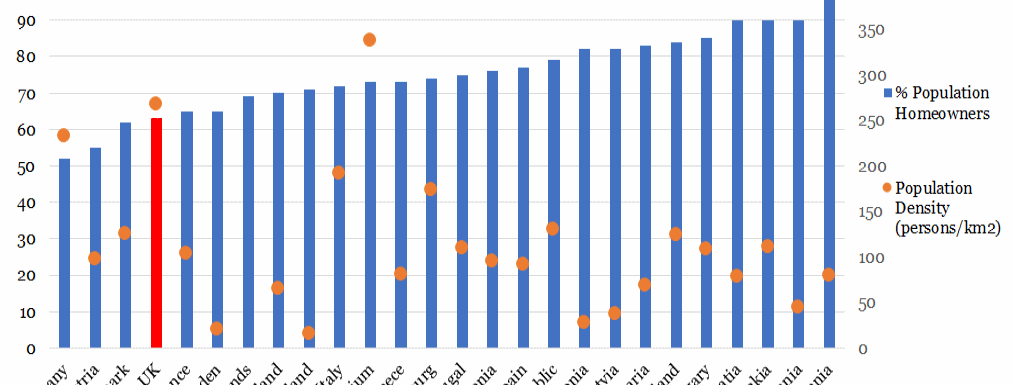
Summary
The chart shows that there is no distinct correlation between rates of home ownership and population density in European countries. The home ownership data shows that the majority of the population in all the selected European countries own homes. European home ownership rates in 2016 were at an average of 69.2 percent, 4 percentage points lower than rates prior to the financial crisis. The country with the highest rate of home ownership is Romania, where 97% of their population owns a home. However, Romania’s population density is one third that of Germany’s, which has the lowest rate of home ownership (52%) among the nations shown. The Netherlands has the highest population density of 393 persons/km2 but has the seventh lowest home ownership rate. Finland has the lowest population density of 16 persons/km2 and is only two places above the Netherlands in terms of home ownership rates.
What does the chart show?
The blue bars show the percentage of citizens that own a home, measured on the left-hand axis. The orange dots represent the population density in persons per kilometre squared, measured on the right-hand axis. The home ownership rate for the UK is highlighted in red to facilitate comparison. The data is organised by ascending home ownership rates, with the lowest starting on the left. The data includes the nations for which Eurostat has available home ownership data for 2016. The population density figures originate from World Atlas Data.
Why is the chart interesting?
Considering that Germany has the lowest home ownership rate, relatively high population density and yet is acknowledged globally as one of the most prosperous European economies; their housing market is of interest. In the decade prior to 2016, UK residential property prices have almost doubled, while Germany’s rose only by 2-3%. Germany has a high supply of rental accommodation, as German housing associations and municipal authorities hold 12% of stock, private housing companies hold 10%, and property funds have 1%. The remaining stock is held by private investors. There is also variation between cities in Germany. For example, in Berlin and Hamburg, the rental property rates are 90% and 80% respectively, but in states such as Saarland and Rhineland, the majority of their population own homes. In addition, German government tax and policy on housing makes it more difficult to own homes. Citizens anticipate that the property transfer tax, Grunderwerbsteuer, will rise to about 5% in many states, an average increase of 1%. Germany also did not experience a housing boom in the past two decades, and their real house prices fell since the mid 1990s, unlike the majority of European states.
In Romania, while some analysts may assert that the high home ownership rate can be attributed to its cultural value in Central and Eastern Europe (other nearby nations such as Croatia, Lithuania and Slovakia also report high rates of almost 90%); the Romanian government cites their transition from a planned to market economy as a key factor in shaping their housing sector. Where homes in the east were previously seen as an entitlement for all citizens, they have recently shifted to being treated as goods to be bought and sold. There was mass privatisation in the 1990s of state-owned homes for minimal prices. Within the same decade, public sector home ownership declined to only 5% of the housing stock. However, the high home ownership rate is accompanied by overcrowded homes for almost half of the population, an area concern for government policy. In Europe, the issue of overcrowding is due to effects of the financial crisis on the housing sector, unaffordable housing for young people, declining incomes, increased costs of living, increased energy prices and the widespread loss of benefits and subsidies. In addition to these factors, Romania specifically faces challenges such as much of the housing stock being aged or ruined, negative equity, frequent flooding and inefficient energy usage.
In the UK, the housing survey reported that the private rental sector has doubled in the past 15 years and the home ownership level is at its lowest in 30 years. Evidently, almost half of English citizens aged 25 to 34 pay rent to a private landlord. Unsurprisingly private rent in London stands significantly higher than outside the capital, with London rent in 2015-2016 (average of £300 per week) double that of outside the city capital. Greece also hit an all-time low home ownership rate of 73 percent, as a result of their economic crash. Greek households spent more than 40 percent of their disposable incomes on housing expenses such as rent, mortgage, electricity and utilities. This is an average of four times more than their European neighbours.
Week 46, 2018

